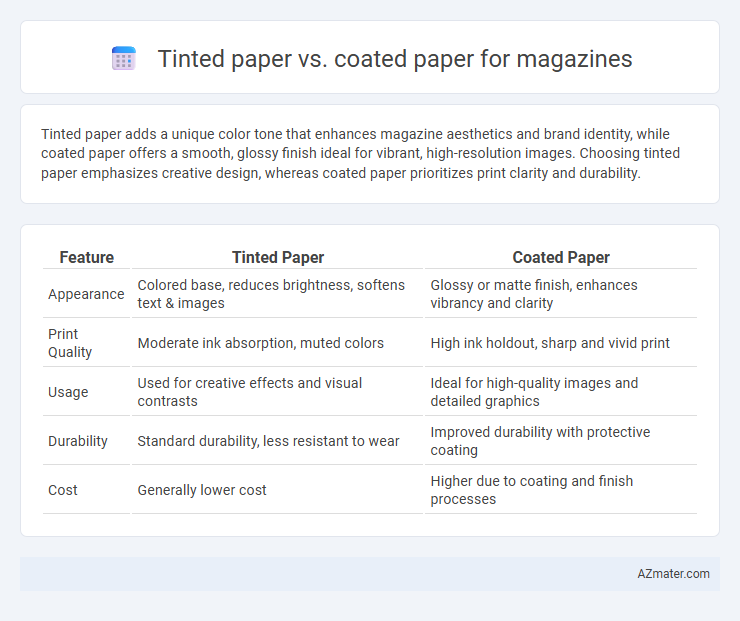Tinted paper adds a unique color tone that enhances magazine aesthetics and brand identity, while coated paper offers a smooth, glossy finish ideal for vibrant, high-resolution images. Choosing tinted paper emphasizes creative design, whereas coated paper prioritizes print clarity and durability.
Table of Comparison
| Feature | Tinted Paper | Coated Paper |
|---|---|---|
| Appearance | Colored base, reduces brightness, softens text & images | Glossy or matte finish, enhances vibrancy and clarity |
| Print Quality | Moderate ink absorption, muted colors | High ink holdout, sharp and vivid print |
| Usage | Used for creative effects and visual contrasts | Ideal for high-quality images and detailed graphics |
| Durability | Standard durability, less resistant to wear | Improved durability with protective coating |
| Cost | Generally lower cost | Higher due to coating and finish processes |
Introduction to Magazine Paper Choices
Magazine paper choices significantly impact print quality and reader experience, with tinted paper providing a unique aesthetic by adding subtle color hues that enhance visual appeal and reduce glare. Coated paper, commonly used for magazines, offers a smooth surface that improves image sharpness, color vibrancy, and durability due to its sealed finish. Selecting between tinted and coated paper depends on the desired visual effect, print accuracy, and budget constraints for the publication.
What is Tinted Paper?
Tinted paper is paper that has been colored during the manufacturing process, offering a subtle hue that enhances the aesthetic appeal of magazine pages. Unlike coated paper, which features a glossy or matte finish to improve print sharpness and durability, tinted paper provides a unique background tone that can reduce glare and soften the overall look of printed images and text. This makes tinted paper ideal for magazines aiming for a distinct visual style or a vintage, elegant feel without sacrificing print quality.
Understanding Coated Paper
Coated paper for magazines offers a smooth, glossy surface achieved by applying a layer of finishing materials like clay or latex, enhancing sharpness and color vibrancy in printed images. This paper type improves ink holdout, resulting in crisper text and richer tones compared to tinted paper, which primarily alters paper color without affecting ink absorption properties. Understanding coated paper's characteristics is essential for publishers aiming to deliver high-quality, visually appealing magazine prints.
Visual Appeal: Color and Finish
Tinted paper enhances magazine visuals by adding subtle color tones that create a unique atmosphere and mood, elevating the overall aesthetic appeal. Coated paper offers a smooth, glossy, or matte finish that intensifies color vibrancy and sharpness, making images and text appear more vivid and professional. The choice between tinted and coated paper significantly impacts the magazine's visual presentation, with tinted paper providing warmth and character, while coated paper ensures crispness and brilliance in color reproduction.
Print Quality Comparison
Tinted paper for magazines offers a unique aesthetic appeal by adding subtle color hues that enhance image depth without the need for additional inks, creating a soft and artistic print quality. Coated paper, with its glossy or matte finish, provides sharper image reproduction and higher color vibrancy due to its smooth surface, which allows for precise ink absorption and minimal dot gain. The choice between tinted and coated paper significantly impacts magazine print quality, where coated paper excels in clarity and brightness, while tinted paper delivers a distinctive, muted visual effect suitable for creative layouts.
Texture and Tactile Experience
Tinted paper offers a unique tactile experience through its subtly colored fibers that create a warm, textured feel, enhancing the sensory engagement of magazine readers. Coated paper features a smooth, glossy, or matte finish that emphasizes sharp image reproduction and vibrant colors, providing a sleek surface optimized for high-resolution visuals. The choice between tinted and coated paper significantly impacts the magazine's overall texture, with tinted paper lending a natural, handcrafted sensation, while coated paper delivers a polished, professional touch.
Durability and Longevity
Tinted paper for magazines offers enhanced UV protection, reducing fading and increasing longevity, but it may be less resistant to moisture and physical wear compared to coated paper. Coated paper features a protective finish that significantly improves durability against scratches, smudges, and environmental factors, making it ideal for high-traffic publications. Both papers contribute to magazine longevity, but coated paper generally provides superior resilience and extended lifespan under frequent handling.
Cost Implications
Tinted paper generally incurs higher production costs due to the additional pigmentation process, which can increase material expenses and slow down printing speeds for magazines. Coated paper, while often more affordable, provides a smoother and glossier finish that enhances image quality without significantly raising costs, making it a popular choice for high-volume magazine production. Balancing cost implications, publishers often choose coated paper for budget efficiency while reserving tinted paper for premium or special edition magazines where aesthetic appeal justifies the expense.
Environmental Considerations
Tinted paper for magazines often utilizes fewer bleaching chemicals and can reduce the need for additional inks, lowering its overall environmental impact compared to traditional coated paper. Coated paper typically involves a clay or polymer coating, which can complicate recycling and increase energy consumption during production. Choosing tinted paper supports sustainable printing by minimizing chemical use and enhancing recyclability, aligning with eco-friendly publishing goals.
Which is Best for Your Magazine?
Tinted paper adds a unique visual appeal and mood to magazines by incorporating subtle color tones directly into the paper, enhancing brand identity and artistic expression. Coated paper delivers sharp, vibrant images with a smooth finish, crucial for high-quality photo reproductions and vivid graphics. Choosing between tinted and coated paper depends on whether your magazine prioritizes aesthetic atmosphere or image clarity for the best reader experience.

Infographic: Tinted paper vs Coated paper for Magazine
 azmater.com
azmater.com